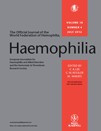Soucek O, Komrska V, Hlavka Z, Cinek O, Rocek M, Zemkova D, Lebl J, Sumnik Z. Haemophilia. 2012 Mar;18(2):222–8. doi: 10.1111/j.1365-2516.2011.02616.x. Epub 2011 Jul 13. IF: 2.364

Department of Paediatrics, Department of Paediatric Haematology and Oncology
Abstract
Although a decreased areal bone mineral density (BMD) has been reported in patients with haemophilia, data are lacking that would reflect the three-dimensional structure of the bone and the muscle-bone relationship. We aimed to assess volumetric BMD, bone geometry and muscle-bonephenotype in boys with haemophilia, and to describe the association between clinical characteristics of haemophilia and bone quality and structure. A cross-sectional study was conducted in 41 boys with haemophilia (mean age 12.4, range 6.6–19.8 years) using peripheral quantitative CT (pQCT) at the nondominant forearm. Results were transformed into Z-scores using previously published reference data. Significant differences were tested by one-sample t-test or sign test. Two-sample t-test and anova were used to compare results between subgroups of patients divided according to the severity of the disease, the fracture history and the number of joint and muscle bleedings. Boys with haemophilia had a decreased trabecularvolumetric BMD (mean Z-score –0.5, P < 0.01), while their cortical volumetric BMD was increased (mean Z-score 0.4, P < 0.05). The volumetricbone mineral content and the bone geometry at the radial diaphysis were normal when adjusted for patients' shorter body height. Muscle area was decreased (mean Z-score –1.0, P < 0.001), irrespective of age. No association was observed of bone quality parameters and bone geometry with the disease severity, fracture history or number of bleedings. Bone strength measured at the diaphysis of the radius is not impaired in boys withhaemophilia. The finding of the decreased trabecular bone density can be most likely attributed to their sarcopenia.
-mk-
